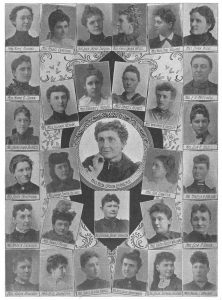Breaking the Barrier:
In the realm of pharmacy, the narrative of progress intertwines with the remarkable contributions of women. With each passing year, their journey within this field becomes increasingly emblematic of resilience, expertise, and transformative leadership. At the heart of medication management lies their dedication, ensuring safety and efficacy for patients worldwide. At IIMT University, acknowledging the pivotal role of women in pharmacy is not just customary; it’s intrinsic to our ethos of inclusivity and recognition of excellence. This blog embarks on an exploration of the indomitable spirit of women in pharmacy, tracing their path through groundbreaking research, corporate leadership, and the relentless pursuit of innovation. As we delve into their achievements, confrontations with challenges, and enduring impacts, we illuminate not just their individual stories, but also the collective narrative of progress they champion.
The Historical Context:
The historical context of women in pharmacy is a fascinating narrative of perseverance, innovation, and societal evolution. Throughout much of history, pharmacy was predominantly a male-dominated field, with women facing significant barriers to entry and advancement. However, their contributions have been pivotal in shaping the profession into what it is today. In ancient times, women often played integral roles in herbal medicine and apothecary practices within their communities.
However, as formalized pharmacy emerged during the Middle Ages and Renaissance, women’s involvement became increasingly marginalized. In Europe, for example, guilds and professional organizations restricted women’s access to formal education and professional opportunities. Despite these obstacles, women persisted in their pursuit of pharmacy knowledge and practice.
In the 19th century, with the advent of industrialization and advancements in science, opportunities for women in pharmacy began to expand. Women like Elizabeth Gooking Greenleaf, who became one of America’s first female pharmacists in the 18th century, paved the way for future generations.
The late 19th and early 20th centuries saw a gradual shift towards greater acceptance of women in pharmacy, particularly in the United States and Europe. The establishment of women’s pharmacy schools, such as the Philadelphia College of Pharmacy and Science for Women (now part of the University of the Sciences), provided formal education opportunities for aspiring female pharmacists. However, progress was slow, and gender discrimination persisted within the profession. Women pharmacists often faced unequal pay, limited career advancement opportunities, and societal expectations regarding their roles as caregivers and homemakers. The mid-20th century marked a turning point, with increasing numbers of women entering pharmacy schools and joining the workforce. The feminist movement of the 1960s and 1970s further propelled efforts to break down barriers and promote gender equality in all professions, including pharmacy.
Today, women make up a significant portion of the pharmacy workforce worldwide, contributing to all aspects of the profession, from clinical practice to research and academia. Their voices and perspectives are essential in shaping the future of pharmacy, as the profession continues to evolve in response to changing healthcare needs and societal dynamics. While challenges remain, the legacy of pioneering women in pharmacy serves as inspiration for future generations to continue breaking barriers and forging new paths forward.
Breaking Barriers in Education and Research:
Breaking barriers in education and research has been a pivotal aspect of the journey for women in pharmacy, shaping both their roles within the profession and the future of healthcare. Historically, women faced significant obstacles in accessing formal education and pursuing careers in pharmacy. However, through resilience, advocacy, and determination, women have progressively shattered these barriers, enriching the field with their unique perspectives and contributions. In the realm of education, women fought for admission to pharmacy schools and equitable opportunities for learning. In the late 19th and early 20th centuries, pioneering women established their own pharmacy schools or gained admission to existing institutions despite facing resistance and discrimination. These efforts led to the gradual integration of women into pharmacy education programs, paving the way for future generations. Today, women represent a substantial portion of pharmacy students worldwide, with many achieving academic excellence and leadership roles within their institutions. Programs and initiatives aimed at promoting diversity and inclusion have further supported the advancement of women in pharmacy education, ensuring equal access and opportunities for all aspiring pharmacists. In the sphere of research, women have made significant strides in advancing scientific knowledge and innovation within the field of pharmacy. Despite historical underrepresentation, women researchers have excelled in diverse areas such as pharmaceutical sciences, clinical research, and pharmacotherapy. Their contributions have led to breakthroughs in drug discovery, pharmacokinetics, pharmacodynamics, and personalized medicine, among other fields. Efforts to promote gender equity in research have included initiatives to address bias, increase representation, and support career development for women in academia and industry.
Organizations and professional societies have played a crucial role in advocating for equal opportunities and recognition of women researchers, fostering a more inclusive research landscape in pharmacy and pharmaceutical sciences.Looking ahead, breaking barriers in education and research remains essential for empowering women in pharmacy and shaping the future of the profession. Continued efforts to promote diversity, equity, and inclusion will ensure that all pharmacists, regardless of gender, have the opportunity to contribute their talents and expertise to improving healthcare outcomes and driving innovation in pharmacy practice and research.
Leadership and Entrepreneurship:
In addition to excelling in academia and research, women have increasingly taken on leadership roles within the pharmaceutical industry. From serving as CEOs of multinational corporations to founding their own pharmaceutical companies, women have demonstrated their aptitude for leadership and entrepreneurship. Figures like Dr. Jane Hsiao, the former Executive Vice President of Research and Development at Warner-Lambert/Parke-Davis, exemplify the trailblazing women who have shaped the pharmaceutical landscape through visionary leadership and strategic decision-making.
Addressing Challenges and Advancing Equity:
Despite their significant contributions, women in pharmacy continue to face challenges such as gender discrimination, wage disparities, and underrepresentation in leadership positions. Recognizing these barriers, efforts have been made to promote gender equity and inclusivity within the profession. Professional organizations and advocacy groups advocate for policies that support women pharmacists, including equal pay initiatives, mentorship programs, and leadership development opportunities. By addressing these challenges head-on, the pharmacy profession can harness the full potential of its diverse workforce and drive meaningful change.
Empowering the Next Generation:
As we celebrate the achievements of women in pharmacy, it is crucial to empower the next generation of female pharmacists. Mentorship programs, educational initiatives, and networking opportunities play a pivotal role in supporting aspiring women pharmacists as they navigate their careers. By fostering a supportive and inclusive environment, the pharmacy profession can inspire future generations of women to pursue their passions and make a difference in the field. Empowering the next generation of women in pharmacy is crucial for breaking barriers and shaping the future of the profession. Mentorship, education, and advocacy are key components in supporting young women as they navigate their careers in pharmacy.
Mentorship programs provide guidance, support, and encouragement to aspiring female pharmacists, helping them overcome challenges and achieve their professional goals. By connecting with experienced mentors who can offer advice and share their own experiences, young women can gain valuable insights and navigate the complexities of the pharmacy landscape with confidence.
Education plays a vital role in empowering the next generation of women Access to quality education and training opportunities ensures that aspiring pharmacists have the knowledge, skills, and competencies needed to excel in their careers. In addition, promoting STEM education and encouraging young girls to pursue interests in science and healthcare can help cultivate a pipeline of talented women entering the pharmacy profession.
Advocacy efforts aimed at addressing gender disparities, promoting diversity, and creating inclusive environments are essential for empowering future generations of women in By advocating for equal opportunities, fair treatment, and recognition of women’s contributions, the profession can continue to attract and retain talented individuals who will shape its future. Through these collective efforts, we can empower the next generation of female pharmacists to break barriers, drive innovation, and lead positive change in healthcare.
Conclusion:
In the tapestry of pharmacy, women have woven an irreplaceable thread, shaping its past, defining its present, and charting its future. Their journey, marked by breakthroughs in education, pioneering research endeavors, and bold leadership strides, stands as a testament to resilience, perseverance, and unwavering dedication. As we reflect on their invaluable contributions, let us not merely admire their achievements but commit to fostering an environment of gender equity and inclusivity. At IIMT University, this dedication to empowering women in pharmacy isn’t just a mission; it’s a cornerstone of our ethos. Together, let’s envision a future where every female pharmacist is celebrated, supported, and given equal opportunities to thrive. By embracing diversity and recognizing the multifaceted talent within our ranks, we can cultivate a vibrant and inclusive pharmacy profession that resonates with the aspirations of female pharmacists worldwide.
Author: Miss. Mansi Aggarwal,
Assistant Professor, SoPS.

